About the Connection Autonomous Research
Since 2010, the Korea Arts Management Service (KAMS) has run the KAMS Connection. This program has supported research on international performing arts markets and development of follow-up projects in order to form a basis for Korean performing arts professionals’ sustainable international exchanges. In 2020, the outbreak of COVID-19 led to a new turn of international exchanges in the performing arts field. In an attempt to try and find alternatives for sustainable cooperation among Korean and international performing arts professionals in the present and future, KAMS carried out a series of programs focused on contactless cooperation: “Korea-Nordic Connection,” “Autonomous Research” and “Support for Development of Outstanding International Cooperation Projects.” Through these programs, KAMS selected ten projects. And here is an essay written by Ms. Choah Park, a producer who was selected for the “Autonomous Research.”
Essay on the Connection Autonomous Research (1)
Fictional Reality in-between Games and Performances
Choah Park (independent producer at the arts agency Uechoah)
1. Gaming as an Active Medium
Today, there are so many ways to consider games. Some say that games just make us waste our time happily. However, I believe that today’s gaming industry shows our society’s near future. And going further, I regard games as cultural content that deals with what is going on in a gamer’s head. The reason why today’s games are believed to have great potential is gamers’ activeness. Indeed, such activeness has steadily grown with the development of the gaming industry. In the past, people played console/arcade games alone. Later on, they came to play competitive games and online multi-player games. In this manner, games have become more experience-based and more realistic, enabling more active communication.
The pandemic has resulted in unprecedented invigoration in the game industry. While broadcasting is a relatively passive medium that provides viewers with transmitted videos, gaming is about allowing each player to restructure their world as an active participant. Particularly in an open-world game, a player runs a world in there by actively making a decision every moment. The player may complete a given task rapidly and move on to the next level but they can also choose to avoid and delay the task or deliberately repeat their death. Everything is up to them. The gamer’s choices complete the game world’s storytelling. And the story is restructured every time. That is why a game has a huge number of cases. Depending on each player’s tendencies and the decisions they make every moment, a game tells different stories.
2. From a Game “I Play” to a Game “I Watch”
In my view, the launch of open-world games has provided players with an unprecedented level of activeness and openness. Gamers adopt different routes and methods. So they feel the need to enjoy a game in their own way and to share it with others. At the same time, they have a growing desire to look at how others are playing. This triggers the growth of an industry of “watching” games in addition to the one of “playing” games. I often see those who ask me why people would watch others play games instead of playing them on their own. But in fact, people do visit game streaming channels to watch each streamer’s game storytelling. That is another particularity and inflection point that have appeared in the recent gaming industry. A game streamer is totally different from an announcer who objectively explains what is going on in a game as a third person. A game streamer actively plays a game while also providing quite fictional and subjective commentaries and performances. In other words, they manipulate game characters and operate a game from a first person’s point of view. At the same time, they subjectively evaluate their performance and they feel free to share their personal views with those watching their channel. A streamer communicates through their real-time transfer between multiple layers of activities: the world in a game, their fictional broadcasting performance and quite realistic reaction to the online audience of their streaming chennel. People like this organic reaction moving between reality and fantasy. Having great gaming skills doesn’t make you a well-known streamer. Rather than that, the uniqueness and attractiveness of such reaction make you famous. Attractive Twitch/YouTube streamers like Dr. Disrespect also appear on a page of Wikipedia which categorizes them not as persons but as “Internet personalities.” What is obvious is that more and more people are watching these virtual personae’s gaming. I believe that this is not very different from what performing artists call “performance.” Going beyond multiple media and reflecting the reality of multiple self-states, what they do feels like a natural and fictional performance.
3. Cultural Content Representing Social Voices
In today’s cultural content, one of the most powerful media is gaming. In capitalist society, certain phenomena and trends often make themselves visible in the flow of money or more specifically, on the target platforms of commercial advertisements. As time went by, advertisements moved from newspapers to broadcasts and then to Internet websites. More recently, they moved to independent streaming channels such as YouTube and Twitch. Compared to other streaming channels, game platforms deal with relatively bigger amounts of subscribers’ donation, advertising sponsorship and down payments. This implies that gaming now has a powerful ripple effect.
In the 1990s, the world in games was only regarded as a space separate from the real world. It was during this period that a game called GayBlade was launched. This game is not very different from shooting games which are about killing zombies. But what made this game special is found outside. It became special because Ryan Best, then developer of the game, tried to attack Pat Buchanan, politician who didn’t hesitate to make homophobic remarks, by using him as a game character in place of a zombie. Back then, game players used to shoot space invaders invading Earth or pose as a Street Fighter to fight. So such an idea of using a real person was considered quite sensational. At that time, those in the LGBTQ community were engaging in street protests every day to fight for their rights. They reacted to the game character with enthusiasm because they could kill him as much as they wanted. Up until now, GayBlade is regarded as the first game of going beyond simple game playing to deal with an actual social issue. Becoming a legend, the game led other social issues to knock on the door of the gaming world. Gaming has grown into influential cultural content by taking into account its closer connection with members of society. Today, many people integrate such social issues into games.
I recently came to learn about the Uncensored Library, an exhibition and Minecraft content. The idea behind this work greatly inspired me. On March 12, 2020, World Day Against Cyber Censorship, this library was opened in Minecraft. The library exhibits over 200 books that have been censored from around the globe. It has rooms for different countries including Russia, Vietnam, Saudi Arabia and North Korea. And the library makes public each country’s censored articles. You can freely read the documents by logging on to Minecraft or by downloading a map from an independent website. The library has recently added the COVID-19 room to exhibit books on the media’s alleged manipulation and concealment regarding coronavirus issues. In an attempt to protect free speech, the library raises awareness of media censorship and encourages solidarity by transparently sharing with the young what is censored today.

Room for Saudi Arabia in the Uncensored Library ⓒReporters Without Borders
4. Blurring Boundaries between Fantasy and Reality
Generalization of first-person 3D games has enabled immersive gaming experiences at home. In parallel, easier interaction among multiple players in the online network has blurred boundaries between fantasy and reality in the gaming world.
‘Fortnite X Travis Scott’
On April 23, 2020, online players of Fortnite went crazy. That was because famous rapper Travis Scott released his new song called "Astronomical" in Fortnite. Kept secret outside, the song was first released only in the virtual space of Fortnite. The song hadn’t been released anywhere else so it was the world premiere. To watch this virtual live concert, more than 12 million Fortnite players logged on to the game and Fortnite announced that such a number was an all-time record. As Scott’s large skin fell on the specially installed, virtual stage in Fortnite like a comet, players became enthusiastic about such a new virtual experience. Of course, it was a virtual concert without any real person but the event’s only one eight-minute video attracted over 100 million viewers. In addition, innumerable game streamers uploaded videos of what they had experienced during Travis Scott’s concert on their YouTube channels, thus producing a huge number of different videos reacting to the event.

Screenshots of Travis Scott X Fortnite ⓒEpic Games
‘NET-A-PORTER Island in Animal Crossing: Isabel Marant Collection’
Last month, the famous online shopping mall NET-A-PORTER opened a fantasy island in Animal Crossing. Avatars of NET-A-PORTER’s crew walked around the island wearing clothes from an exclusive collection made in collaboration with French fashion designer Isabel Marant. Not only the crew but also numerous customers visited the NET-A-PORTER Island through the Dream Address code of Animal Crossing (DA-9835-1060-5257). The visitors looked around the apparel designs and thieir avatars had a chance to try the clothes on. As the shopping mall is focused on both fashion and lifestyle, this island has more than clothes. For example, it has meticulously designed spa, yoga class, meditation session, fitness center, beach with virtual sunshine and coffee shop with “fantasy cappuccino.” These virtual facilities help customers, who have been suffering from the “corona blues,” escape from their reality. Such online activities may look like those for children who enjoy their dolls and play house. However, the business strategies behind these cute avatars are more elaborate and commercial than you would expect; they are so realistic. For this collaboration, Isabel Marant virtualized her FW 2020 collection items. She made the items look as much as like actual ones and gave them to digital avatars. All these items were launched exclusively for NET-A-PORTER. On this island, everyone can wear clothes designed by Isabel Marant, enjoy the spa and and lie down on the beach to soak up the virtual sun. But at the same time, they can always go to the website of NET-A-PORTER in the real world, through a QR code.
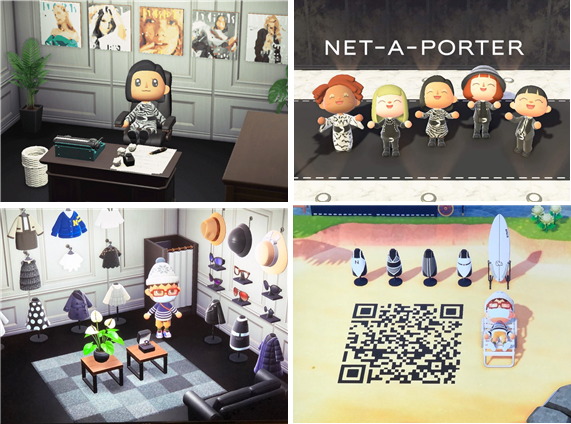
Screenshots of the NET-A-PORTER Island in Animal Crossing ⓒNET-A-PORTER, Choah Park
In a remarkable way, these events familiarize gamers with the virtual spaces and make them stay focused by combining their active participation and online game platforms’ extreme fictionality. This is something to take note of because players don’t just consume given content on online platforms but they “generate virtual, fictional reality together.” Elements of reality have been completely absorbed into the virtual platforms of games. Consequently, we can’t say that an event in a game isn’t a reality. That is because boundaries between fantasy and reality have become meaningless.
5. Games in Korean Works
① Performance: ‘Meta Performance: Future Theater (2020)’ by Gyeonggi Sinawi Orchestra / Venue: Twitch
‘Meta Performance: Future Theater (2020)’ is a Korean case of planning an online performance on the basis of Twitch, from the planning phase. The performance tells a story about destroying a traditional theater and building a future theater. Such a story and structure of the performance were completed thanks to the real-time participation of online viewers on Twitch. For this performance, online and offline viewers chose the songs and dances they wanted to enjoy and they also decided their order. In this way, they participated in the idea of building a future theater together. The performance has a hybrid form combining online and offline spaces. Some of its audience watch the performance in an offline theater. Others experience and relay the performance through a first-person camera and computer. There are also those who participate in the performance online from Twitch. The entire performance was relayed with commentaries provided by a traditional Korean musician. For those who have felt the limitations of online performances throughout this year, this event demonstrated that a game platform has great potential to have people participate in an online performance and to have them stay focused. This is how the show was acclaimed by the audience.
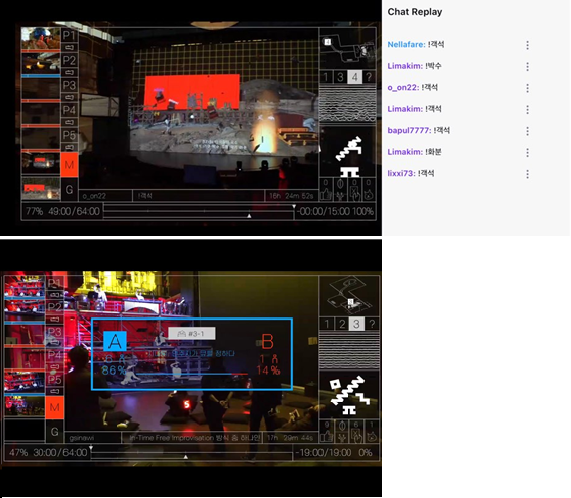
Screenshots of ‘Meta Performance: Future Theater (2020)’ on Twitch ⓒGyeonggi Sinawi Orchestra
② Exhibition: ‘MOE (2020)’ by Gyeonggi Children’s Museum / Venue: Animal Crossing
These days, we even feel reluctant to visit crowded exhibitions. If that’s the case, how would a virtual exhibition in a game change your experience? In ‘MOE (2020)’, the entire island is comparable to a museum package. Once players reach this place through the Dream Address code (DA-2548-8029-7291) or a password, they can look around the virtual exhibitions found all over the island and explore the island. Such exhibition spaces also have completely virtual elements that aren’t found in regular museums. The island has not only exhibition spaces but also many other facilities including a museum shop, a coffee shop, the museum director’s office and the curator’s office. In this way, it seems to unveil the reality behind the scene. Here, you have a chance to go inside the museum director’s office, which looks somewhat luxurious and elegant. You can also enter the curator’s office. It has a bed in its corner; the curator may have to work overtime frequently. So in addition to enjoying the exhibition, you feel subtle déjà vu and relate to those in the art scene. When you leave the island, you have not only an experience of a virtual exhibition but also certain familiarity with the art scene.
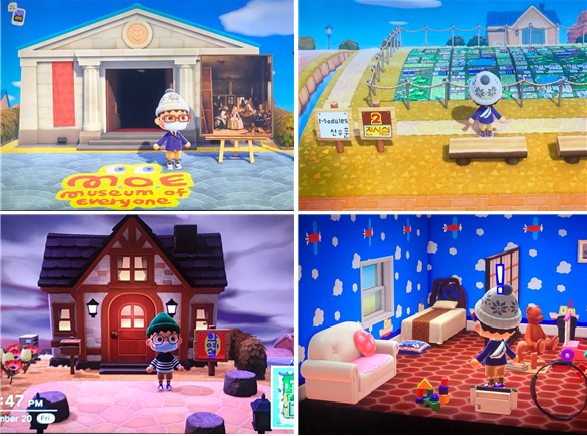
Screenshots of the first exhibition space and the curator’s office of ‘MOE (2020)’ in Animal Crossing ⓒChoah Park
③ Performance: ‘The House of Sorrow (2020)’ by Kim Jisun (performance presented at the Kunstenfestivaldesarts (KFDA)) / Venue: Minecraft + internally developed game
‘The House of Sorrow (2020)’ by Kim Jisun is not really a specific game but it adopts the form of game streaming. A game streamer actually runs the game on stage. This intermediary, who is a performer and streamer, connects the fictional performance, the virtual world in the game and the theater space where there are the audience. And this person ceaselessly moves between these spaces. In this way, the streamer performs in a form we have never seen before. This person is actually neither a streamer nor a performer and is found in between, with unique characteristics. ‘The House of Sorrow (2020)’ was first produced as a performance for an offline theater. As the pandemic forced the artist to consider an online performance at KFDA, she didn’t want the performance to be confined to a video shared with the online audience. So the artist made a virtual space in Minecraft so that online viewers could gather together there to watch the performance. While waiting for the performance, online players look at the map of the theater built in Minecraft. As they look around the busy street near the theater and those drinking in a pub in front of the building, they have an experience of a virtual audience, which is similar to but different from reality.
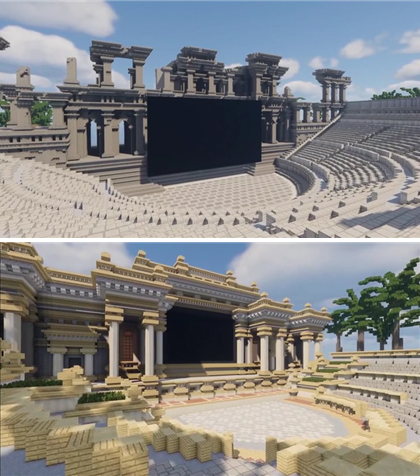
Screenshot of the trailer of ‘The House of Sorrow (2020)’ and the Minecraft theater designed for the online audience ⓒKim Jisun
6. Game and Performance
It has been quite a long time since games freed themselves from their position of basic entertainment. From a creator’s perspective, what would it mean to design a game successfully? That would not be only about what characters and images a designer puts into the game. This is rather about what is going on in the gamer’s head and about how they think. That is why game designers consider unspecified players and try to look into their heads. The gaming industry now looks deep inside people’s ways of thinking, lifestyles and awareness systems to reflect all these elements. I believe that this is similar to what performing artists do because they also consider the audience coming to the theater in order to make a structure for a performance. Contemporary performing artists have thought about what new sensibilities and thoughts could be triggered in the heads of the audience looking at the stage. In the same vein, I’m eager to see if the performing arts could take a step toward a new form along with games. So I’m curious about upcoming hybrid works.
[References]
"GayBlade: The Lost LGBTQ Roleplaying Game, Explained". Comic Book Resources. August 22, 2020. Retrieved November 28, 2020.
Scott, Jason. "The Legend of GayBlade". Internet Archive. August 28, 2020. Retrieved November 30, 2020.
“High Score”, Netflix docuseries. Created by France Costrel and produced by Great Big Story. Premiered on August 19, 2020.
“Fortnite and Travis Scott Present: Astronomical”. Epic Games. April 21, 2020. Retrieved November 10, 2020.
“NET-A-PORTER Island Comes to Animal Crossing”. NET-A-PORTER. August 20, 2020. Retrieved November 30, 2020.
https://uncensoredlibrary.com/en
Author: Choah Park
Choah Park majored in astrophysics and performing arts studies and she started her career in the contemporary dance scene in 2008. After working at the Ahn Aesoon Dance Company, HanPAC and Korea National Contemporary Dance Company, she founded the arts agency Uechoah. She currently serves as an independent producer.
Email: contact@uechoah.com








 PREV
PREV



.png)
.png)
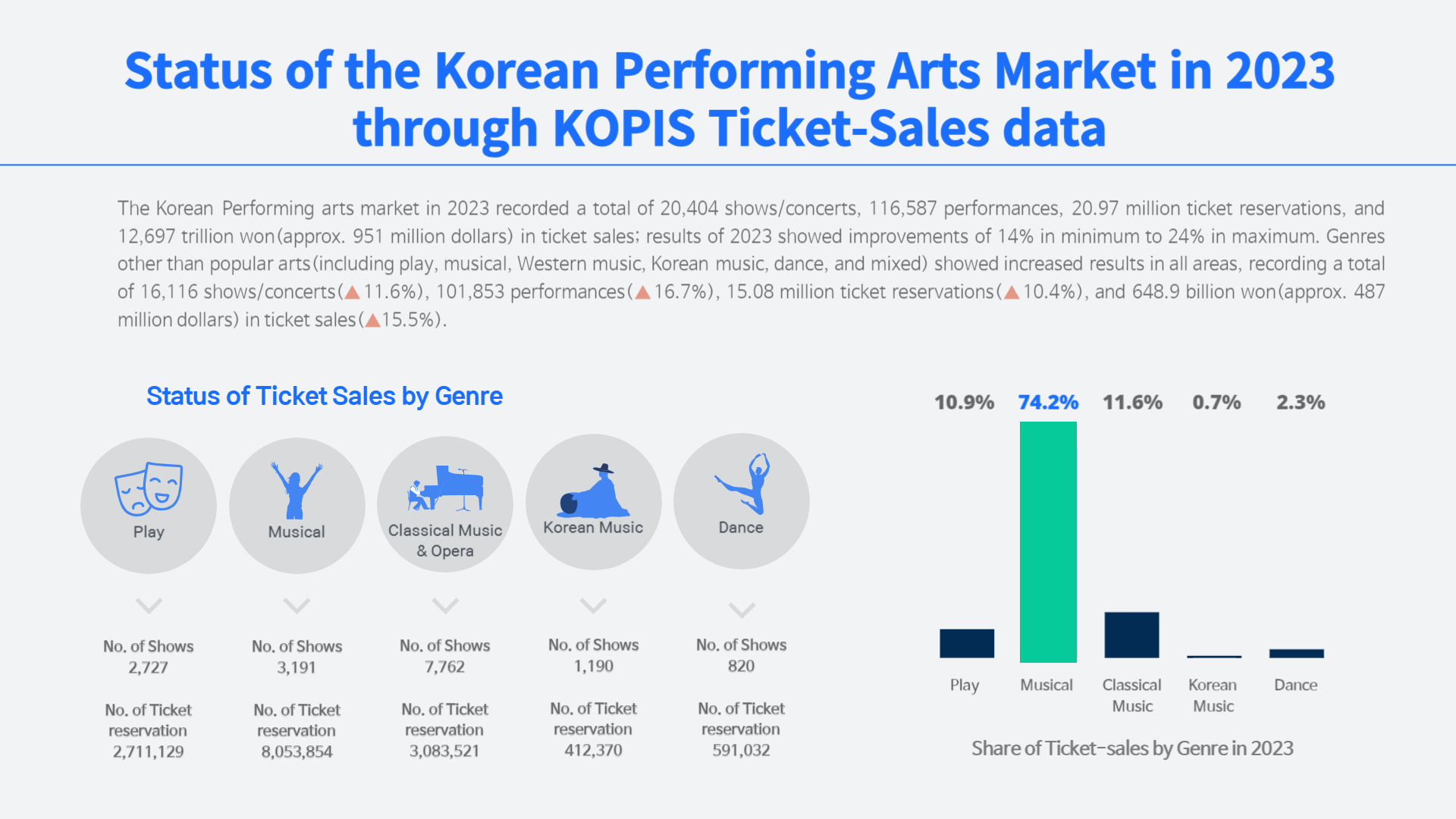
.jpg)
.jpg)
.jpg)
.jpg)











